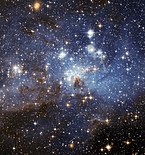| Star formation |
|---|
 |
| Object classes |
| Theoretical concepts |
Planetary migration occurs when a planet or other body in orbit around a star interacts with a disk of gas or planetesimals, resulting in the alteration of its orbital parameters, especially its semi-major axis. Planetary migration is the most likely explanation for hot Jupiters (exoplanets with Jovian masses but orbits of only a few days). The generally accepted theory of planet formation from a protoplanetary disk predicts that such planets cannot form so close to their stars, as there is insufficient mass at such small radii and the temperature is too high to allow the formation of rocky or icy planetesimals.
It has also become clear[citation needed] that terrestrial-mass planets may be subject to rapid inward migration if they form while the gas disk is still present. This may affect the formation of the cores of the giant planets (which have masses of the order of 10 to 1000 Earth masses), if those planets form via the core-accretion mechanism.